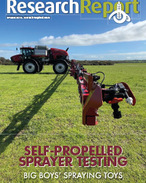This article is 8 years old. Images might not display.
But there are many other factors to consider when sowing perennials, including planning and paddock preparations which begin two years prior to sowing.
THINKING AHEAD
The high cost associated with sowing permanent perennial pastures in temperate regions of Australia means that establishment must be successful. It takes about 10 years to recoup the cost of pasture establishment, so the species sown must persist and achieve adequate production levels for at least this length of time.
It is also not good enough to achieve an only partially successful level of establishment. This is a difficult situation because the newly sown pasture is too good to spray out, but at only satisfactory establishment levels, will never achieve its productive potential. Decisions must be made about economics and likely success of re-sowing to some extent.
PRE-SOWING WEED CONTROL
To achieve the essential weed-free seed bed prior to sowing perennial pastures, start using a variety of strategies at least two years prior to sowing to completely rundown seed banks.
This is especially important for annual grass weeds such as barley grass, vulpia and ryegrass as there are no herbicide options to control these species once pasture grasses have germinated.
If herbicides are to be used at any stage of your weed management program, ensure all equipment used is regularly calibrated. Check labels carefully for plant back periods for pasture species if residual chemicals are used, and for stock withholding periods.
Spray topping (pasture topping) is the application of a non-selective herbicide (either paraquat or glyphosate) at a low rate just after the weed seed head has emerged, to sterilise the seed. Timing is critical for the effectiveness of this technique. Heavy grazing or slashing in winter and spring and then removing stock 2-3 weeks prior to topping will produce an even head emergence for maximum effectiveness. Read the chemical label to determine the best growth stage of the dominant weed or weeds to target when spraying.
Spray-grazing can be an effective technique for managing many broadleaf weeds in established pastures. A sub-lethal rate of herbicides such as MPCA or 2,4-D amine are sprayed onto target weeds in the rosette stage and while they are actively growing. After the grazing withholding period has passed, use high stocking rates of older, non-breeding stock (preferably sheep) to heavily graze the weeds while their plant sugar levels are high and they are more palatable to stock. Use with caution and advice on lucerne and medic pastures, and watch for animal health issues if targeting weeds such as Paterson's curse variegated thistle and caltrop.
Strategically cutting paddocks for hay or silage can effectively reduce weed seed set, especially when used with grazing or follow-up herbicide treatments to manage regrowth and late seed set. Similarly, growing a forage crop such as a brassica or winter cereal can also reduce the seed bank by out-competing the annual weeds.
In the months prior to pasture sowing, use a chemical spray fallow in the spring (noting plant back periods) to achieve total weed control. A cultivated fallow is a less preferred option as it leaves the paddock exposed to erosion and may not kill all weeds.
KEEPING PESTS AT BAY
Newly sown pastures must be continually monitored for weeds, diseases and pests as these most commonly cause establishment failure, especially weeds. While grass weeds must be controlled before sowing, broadleaf weed seedlings can be controlled through the correct application of selective herbicides. Apply when the weeds are young and actively growing as per label directions. If applied late in the season, herbicides will significantly reduce the seed production of annual legumes.
Diseases affecting pasture are often expensive to treat, so prevention is a more economical approach. Sow pasture varieties resistant or tolerant to common disease where possible and maintain plant vigour through adequate moisture and fertiliser. Strategically graze or harvest paddocks to open the canopy and remove dead material which may harbour disease, and practice good hygiene when moving farm equipment around the property.
Watch out for pest attack, especially as seedlings are emerging, and treat early if required. Ensure pests are correctly identified and the true extent of the infestation is known before applying pesticides. Also consider the pests' life cycle stage, ability of the pasture to ‘ride out' the attack and economics of applying a pesticide.
There are many beneficial insects found in pastures including spiders, ground beetles and ladybirds and damsel bugs. Pesticides will negatively impact these beneficial bug populations so should be used judiciously. This will also reduce the likelihood of pests developing resistance to chemicals.
GRAZING MANAGEMENT
The key points to remember when managing the grazing of newly sown pastures are:
- Pastures less than 12 months old should not be grazed if they are moisture stressed or under very wet conditions,
- Graze new pastures only when they are at least 10cm tall and well anchored by the roots,
- In the first year, ideally only graze briefly in spring at high densities and under favourable conditions,
- Allow new pastures to set seed in the first year, for regeneration and root development, and
- Never make hay or silage from pasture in the first year.
The grazing management of established pastures should be reviewed regularly as different perennial species will respond differently to grazing. Determine the carrying capacity of an area and aim to graze it in a way and at a time that will favour the persistence of desirable species and maintain a competitive pasture base.
FERTILISER NEEDS
The higher the stocking rate and production demanded from pasture, the higher the nutrient needs of the pasture plants will be to persist and maintain vigour. Regular soil tests will help to determine the fertiliser rates required to maintain soil fertility, so nutrient inputs match nutrients exported from the paddock. The general rule of thumb is for every DSE/ha run on the paddock, allow one kilogram per hectare of each of phosphorus and sulphur.
A more refined fertiliser program can be developed using the ‘Five Easy Steps' information package available on the MLA website in the ‘Tools and Calculators'. This package helps producers match fertiliser rates to soil type, growing season and stocking rates.
Prioritise paddocks for fertiliser application, starting with the most recently established and special purpose pastures. Take care to apply fertiliser at the most appropriate time to coincide with pasture growth whilst avoiding cold, wet conditions. Keep appropriate records for both chemical and fertiliser applications, and adjust stocking rates to utilise the extra feed produced in fertilised paddocks to make sure the exercise is economically worthwhile.
MORE INFORMATION























